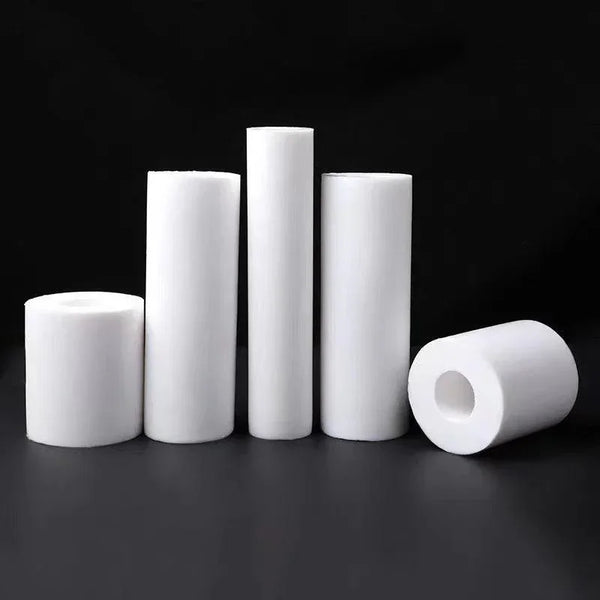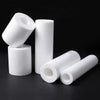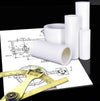White PTFE Hollow Rods – 25–50cm, High Temp & Corrosion Resistant
Expected Delivery on - .
Free Shipping & Return
Money back guarantee
Fast & reliable support
Secure payment
Free standard shipping provided, no shipping fee required. Contact customer service for expedited shipping. Return within 30 days, duties & taxes non-refundable.
- Length 50cm / OD12mm hole8mm - $36.00
- Length 50cm / OD14mm hole8mm - $37.29
- Length 50cm / OD12mm hole6mm - $37.85
- Length 50cm / OD16mm hole 6mm - $38.28
- Length 50cm / OD18mm hole8mm - $38.92
- Length 50cm / OD18mm hole10mm - $39.46
- Length 50cm / OD18mm hole12mm - $40.01
- Length 50cm / OD18mm hole14mm - $40.05
- Length 50cm / OD20mm hole8mm - $40.16
- Length 50cm / OD20mm hole10mm - $40.47
- Length 50cm / OD23mm hole13mm - $41.16
- Length 50cm / OD24mm hole12mm - $44.08
- Length 50cm / OD24mm hole16mm - $44.62
- Length 50cm / OD25mm hole15mm - $45.08
- Length 50cm / OD27mm hole13mm - $50.04
- Length 50cm / OD28mm hole16mm - $52.56
- Length 50cm / OD28mm hole20mm - $55.28
- Length 50cm / OD30mm hole10mm - $58.20
- Length 50cm / OD30mm hole17mm - $60.92
- Length 50cm / OD30mm hole20mm - $64.44
- Length 50cm / OD32mm hole22mm - $68.55
- Length 50cm / OD33mm hole16mm - $73.80
- Length 50cm / OD35mm hole20mm - $78.12
- Length 50cm / OD40mm hole25mm - $81.52
- Length 50cm / OD42mm hole30mm - $83.92
- Length 50cm / OD45mm hole32mm - $85.32
- Length 50cm / OD52mm hole40mm - $88.82
- Length 50cm / OD55mm hole45mm - $92.12
- Length 10cm / OD12mm hole8mm - $36.00
- Length 10cm / OD14mm hole8mm - $36.50
- Length 10cm / OD12mm hole6mm - $36.57
- Length 10cm / OD16mm hole 6mm - $36.80
- Length 10cm / OD18mm hole8mm - $36.85
- Length 10cm / OD18mm hole10mm - $36.90
- Length 10cm / OD18mm hole12mm - $37.15
- Length 10cm / OD18mm hole14mm - $37.76
- Length 10cm / OD20mm hole8mm - $38.17
- Length 10cm / OD20mm hole10mm - $36.61
- Length 10cm / OD23mm hole13mm - $36.92
- Length 10cm / OD24mm hole12mm - $35.82
- Length 10cm / OD24mm hole16mm - $35.32
- Length 10cm / OD25mm hole15mm - $38.40
- Length 10cm / OD27mm hole13mm - $39.59
- Length 10cm / OD28mm hole16mm - $40.83
- Length 10cm / OD28mm hole20mm - $38.97
- Length 10cm / OD30mm hole10mm - $44.58
- Length 10cm / OD30mm hole17mm - $42.76
- Length 10cm / OD30mm hole20mm - $37.52
- Length 10cm / OD32mm hole22mm - $39.76
- Length 10cm / OD33mm hole16mm - $45.68
- Length 10cm / OD35mm hole20mm - $45.24
- Length 10cm / OD40mm hole25mm - $46.92
- Length 10cm / OD42mm hole30mm - $45.80
- Length 10cm / OD45mm hole32mm - $47.48
- Length 10cm / OD52mm hole40mm - $48.25
- Length 10cm / OD55mm hole45mm - $49.35
- Length 25cm / OD12mm hole8mm - $35.04
- Length 25cm / OD14mm hole8mm - $35.49
- Length 25cm / OD12mm hole6mm - $35.49
- Length 25cm / OD16mm hole 6mm - $36.74
- Length 25cm / OD18mm hole8mm - $38.63
- Length 25cm / OD18mm hole10mm - $39.26
- Length 25cm / OD18mm hole12mm - $40.26
- Length 25cm / OD18mm hole14mm - $40.55
- Length 25cm / OD20mm hole8mm - $40.95
- Length 25cm / OD20mm hole10mm - $41.50
- Length 25cm / OD23mm hole13mm - $38.20
- Length 25cm / OD24mm hole12mm - $40.72
- Length 25cm / OD24mm hole16mm - $41.38
- Length 25cm / OD25mm hole15mm - $42.06
- Length 25cm / OD27mm hole13mm - $46.66
- Length 25cm / OD28mm hole16mm - $47.88
- Length 25cm / OD28mm hole20mm - $48.15
- Length 25cm / OD30mm hole10mm - $51.08
- Length 25cm / OD30mm hole17mm - $53.08
- Length 25cm / OD30mm hole20mm - $54.08
- Length 25cm / OD32mm hole22mm - $55.47
- Length 25cm / OD33mm hole16mm - $54.44
- Length 25cm / OD35mm hole20mm - $57.32
- Length 25cm / OD40mm hole25mm - $59.57
- Length 25cm / OD42mm hole30mm - $63.25
- Length 25cm / OD45mm hole32mm - $68.04
- Length 25cm / OD52mm hole40mm - $73.72
- Length 25cm / OD55mm hole45mm - $76.32
White PTFE Hollow Rods – 25–50cm, High Temp & Corrosion Resistant
PRODUCT DETAILS
White PTFE Hollow Rods – 10–50cm Lengths, Over 30 OD/ID Options, Custom Cut & Machined
Precision-Machined White PTFE Hollow Rods for Industrial, Medical & Food-Grade Applications
Discover our highly customizable PTFE (Polytetrafluoroethylene) hollow rods, engineered for applications demanding extreme chemical resistance, thermal stability, and clean, non-toxic performance. With lengths of 10cm, 25cm, or 50cm and over 30 outer diameter + inner hole combinations (OD12mm to OD55mm), we offer a solution tailored to your exact needs — from sleeve linings and seals to structural spacers and chemical flow systems.
Available Size Options
-
Lengths: 10cm, 25cm, 50cm
-
Outer Diameters (OD): From 12mm to 55mm
-
Inner Hole Sizes (ID): From 6mm to 45mm
-
Popular combos:
OD18mm / Hole12mm, OD24mm / Hole16mm, OD30mm / Hole20mm, OD40mm / Hole25mm, OD52mm / Hole40mm
🔧 Need a custom configuration or tighter tolerance? Send us your drawing or requirement – we’ll handle the rest.
Why Our PTFE Hollow Rods Deliver More Value
-
Made from 100% virgin PTFE, CE-certified – safe for medical, food, and chemical use
-
Extreme temperature range from -200°C to +260°C – maintains shape and properties in cryogenic and high-temp systems
-
Non-reactive to most chemicals – including acids, solvents, and hydrocarbons
-
Low friction, self-lubricating and non-stick – reduces wear and contamination in machinery
-
Wide range of OD/ID combinations – no need for secondary processing, saving time and cost
-
Machinable & modifiable – perfect for CNC, drilling, slotting, or custom forming
Specifications
-
Material: Virgin PTFE (Teflon®)
-
Color: White
-
Lengths: 10cm / 25cm / 50cm
-
Outer Diameter Range: OD12mm to OD55mm
-
Inner Hole Sizes: 6mm to 45mm
-
Tolerance: ±0.5mm
-
Custom Processing: CNC machining, cutting, threading, engraving available
-
Certification: CE Certified
-
Application Use: Food-grade, industrial, chemical, medical, mechanical engineering
Typical Applications
-
Gasket spacers, PTFE sleeve linings
-
Low-friction mechanical supports and bushings
-
Non-stick flow tubes in corrosive systems
-
Structural bridge expansion fittings
-
Medical tube spacers, lab-grade apparatus
-
Chemical and petrochemical equipment seals
Why Professionals Prefer BeePlastic
-
✔ Wide selection of plastic materials (PTFE, PEEK, UHMW, PC, HDPE, ABS, etc.)
-
✔ Flexible, low-MOQ custom machining for exact specifications
-
✔ Engineering team to assist with drawings and material recommendations
-
✔ Save cost by eliminating redundant processing with our ready-to-fit rods
-
✔ Fast global shipping + responsive service = your ideal sourcing partner
Frequently Asked Questions
Can I request a different OD/hole size combination not listed?
Yes, we provide custom cuts, hole adjustments, and even stepped geometries. Just send your specs.
Is this rod food safe and non-toxic?
Absolutely. We use certified virgin PTFE that is safe for food processing, cleanrooms, and labs.
Can you provide bulk pricing or machining service?
Yes. We support bulk orders with tiered discounts, and provide CNC and fabrication for your parts.
How fast can I get a custom order?
Standard sizes usually ship in 1–2 days. Custom jobs take 3–7 working days depending on complexity.
Ready to Reduce Material Waste and Boost Precision?
🟢 Get a Custom Quote Today →
🟢 Need Help Choosing a Size? Chat with Our Experts
🟢 Explore All PTFE Rod & Tube Options
BeePlastic helps businesses worldwide reduce costs and simplify procurement through precision plastic parts – your needs, our custom solution.
REVIEWS
SHIPPING & RETURNS
Shipping Information
Free Standard Shipping
We offer free standard shipping on all orders. Delivery time is approximately 10-25 business days, depending on your location and carrier performance. Tracking information will be provided once your order is shipped.
Express Shipping Available
Need your order faster? We offer express shipping with delivery in 4-7 business days. Express shipping fees are calculated based on your specific shipping address. To arrange express shipping, please contact our customer service team at beeplastic@beeplastic.com or via WhatsApp before placing your order. Our team will confirm the express shipping cost and process your request.
Processing Time
Standard items: Ships within 1-3 business days
Custom items: Requires 7-10 days production time before shipping
Returns & Refunds Policy
Important Notice: Returns are accepted ONLY for products with quality defects. Non-defective items cannot be returned or refunded.
Standard Items (Non-Customized Products)
Standard items without quality defects are not eligible for return or refund. If you receive a standard item with manufacturing defects or quality issues, you may request a return or replacement within 30 days of receipt.
Custom Items (Made-to-Order Products)
All customized products are NON-RETURNABLE and NON-REFUNDABLE under any circumstances. This includes any items manufactured according to your specific dimensions, shapes, quantities, or specifications. Please carefully verify your requirements before placing a custom order.
Quality Defects - How to Report
If you receive a product with quality defects, please contact us within 7 days of receipt at beeplastic@beeplastic.com. Include your order number, clear photos or videos showing the defect, and a description of the problem. Our quality team will review your case within 24 hours and provide a solution (replacement or refund) if the defect is confirmed.
Damaged During Shipping
Please inspect your order immediately upon delivery. If items are damaged during transit, contact us within 48 hours with photos of the damaged items and packaging. We will arrange a free replacement or full refund at no cost to you.
Non-Returnable Items
The following items cannot be returned: All custom-made products, items without quality defects, products damaged due to improper use or storage, and items returned without prior authorization from our team.
Refund Process
For approved returns, refunds will be processed within 10-15 business days after we receive and inspect the returned item. Refunds will be credited to your original payment method. Please allow an additional 5-7 business days for your bank or credit card company to process the refund. You will receive email confirmation once the refund is issued.
EU 14-Day Cooling-Off Period
For non-customized items shipped to EU countries, you have the right to cancel within 14 days of receipt under EU consumer protection laws. However, this right applies only to items with quality defects. Custom-made items remain non-returnable under all circumstances, as permitted by EU regulations for personalized goods.
Contact Us
For any questions about shipping or returns, please contact our customer service team:
Email: beeplastic@beeplastic.com
Response Time: Within 12 hours
We are committed to ensuring your satisfaction and will work with you to resolve any issues promptly and professionally.
CUSTOM FABRICATION
Can't Find the Right Size or Specification?
If our standard products don't match your requirements, we offer comprehensive custom fabrication services. Whether you need a specific dimension, unique shape, different thickness, or special material grade - we can manufacture it to your exact specifications.
Our Custom Capabilities
Precision Machining:
CNC machining, laser cutting, drilling, milling, and turning with ±0.03mm tolerance. Suitable for complex geometries and tight specifications.
Size Range:
Thickness: 0.5mm - 300mm
Maximum dimensions: 2000mm × 3000mm
Custom shapes: Round, square, rectangular, irregular profiles, holes, cutouts, and complex contours
Available Materials:
HDPE, PTFE, POM, Nylon, PEEK, ABS, PC, PMMA, PP, PVC, and more. Food-grade, conductive, anti-static, and flame-retardant options available.
Processing Methods:
CNC machining, laser cutting, injection molding, thermoforming, welding, and bonding. Multiple finishing options including polishing, sandblasting, and color matching.
Why Choose Custom Fabrication?
Perfect Fit: Parts manufactured to your exact specifications eliminate the need for modifications or adaptations.
No Minimum Order: Whether you need 1 piece for testing or 10,000 pieces for production, we accommodate all order sizes.
Cost Savings on Volume: Bulk custom orders receive 15-30% discount compared to purchasing multiple standard items.
Expert Technical Support: Our engineering team provides free consultation on material selection and design optimization.
Custom Order Process
Step 1: Contact us with your requirements - dimensions, material preferences, quantity, and application details. Technical drawings (PDF, CAD, DWG) are helpful but not required.
Step 2: Receive a detailed quotation within 24 hours including pricing, production lead time, and technical recommendations.
Step 3: Approve the quote and specifications. For complex projects, we can provide samples for testing before full production.
Step 4: Production begins. Typical lead time is 7-15 days depending on complexity and quantity.
Step 5: Quality inspection and shipping. Every custom piece undergoes strict dimensional checks before delivery.
Industries We Serve
Automotive components, food processing equipment, medical devices, laboratory instruments, packaging machinery, semiconductor equipment, industrial automation, and more.
Get Your Custom Quote Today
Don't see the exact size or specification you need? Let us manufacture it for you.
Contact us: beeplastic@beeplastic.com
Response time: Quote within 24 hours
What to include: Material type, dimensions, quantity, and intended application. If you have technical drawings, please attach them. If not, simply describe what you need and our team will assist you.
Not sure about material selection or specifications? No problem - our technical team will guide you through the process and recommend the best solution for your application.
RECOMMENDED PRODUCTS
Custom Plastic Fabrication
1pc to 10,000+ | ±0.03mm | No MOQ
General
HDPE
PP
PVC
ABS
Engineering
POM
Nylon
PC
PMMA
High-Performance
PEEK
PEI
PTFE
Composites
FR-4
G10
Flexible
TPU
Silicone
Why Choose BeePlastic?
Get Quote in 24h
Industries: Automotive • Medical • Food • Lab • Semiconductor
Free consultation → beeplastic@beeplastic.com
RECENTLY VIEWED PRODUCTS
24H QUOTE DELIVERY
Upload CAD, get quote in 24 hours
FREE RETURNS
30-days free return policy.
SECURED PAYMENTS
We accept all credit cards.
24/7 HELP CENTER
Dedicated 24/7 support

























